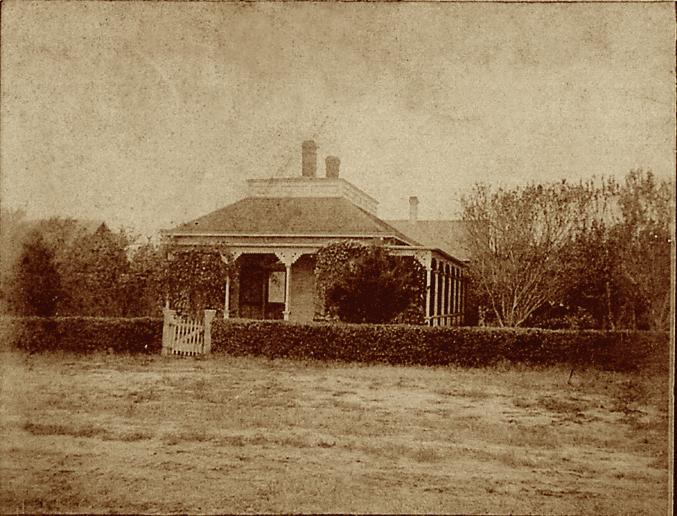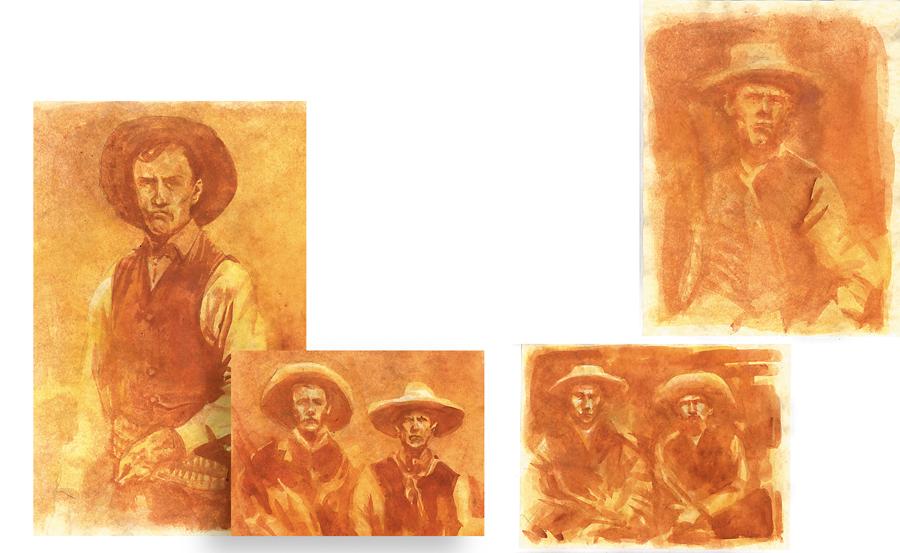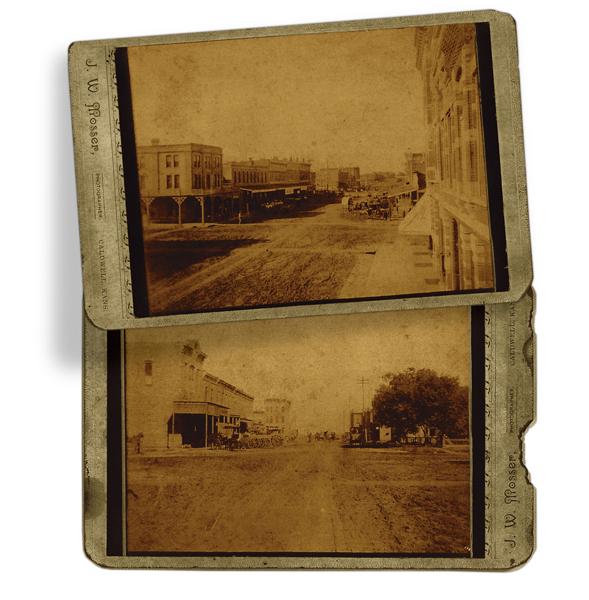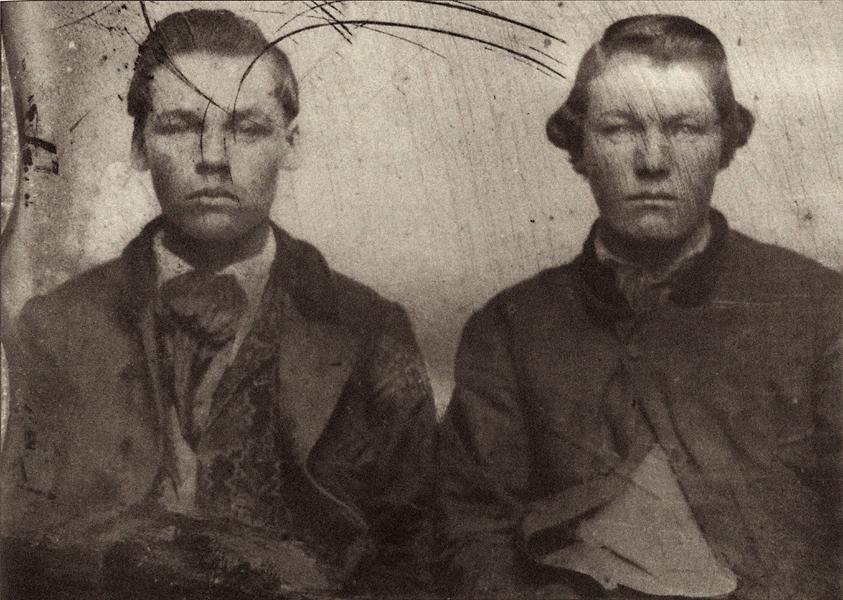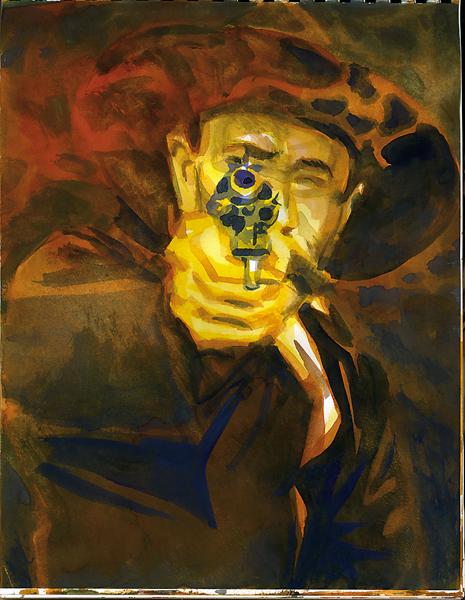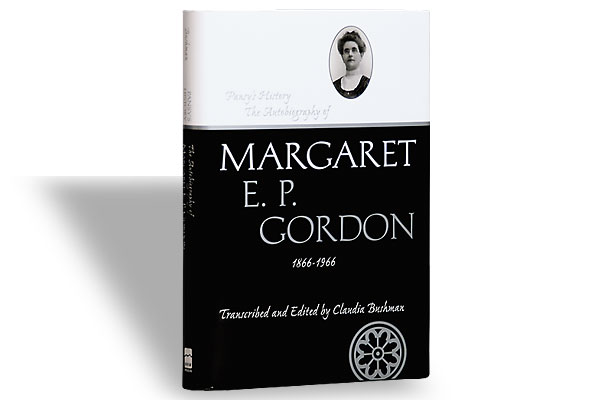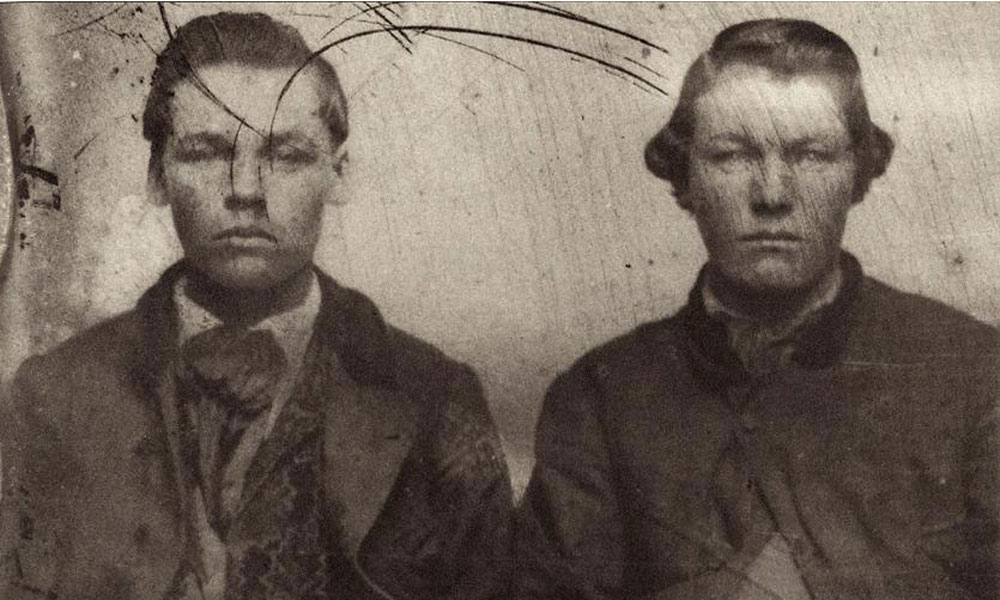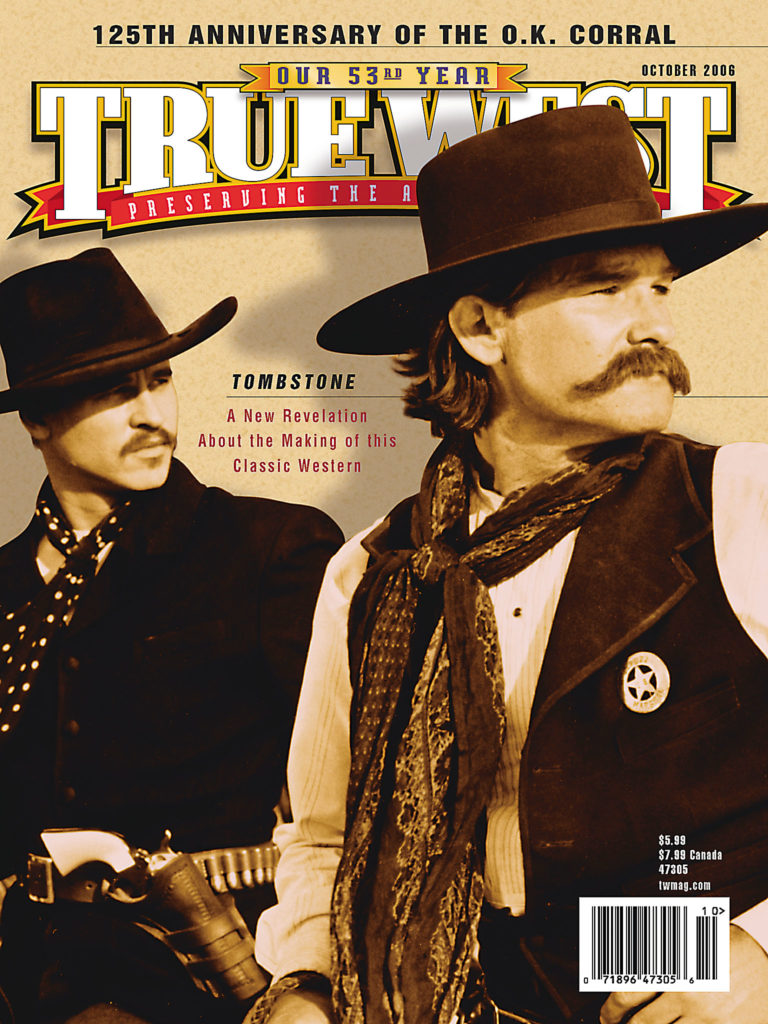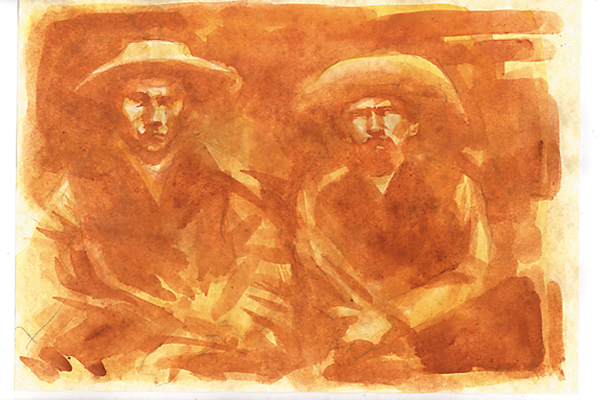 December 17, 1881
December 17, 1881
Cowboy James Talbot gets word that his Texas pards are in a jam—again. Hitching a ride on a passing wagon, he and former Deputy Marshal Dan Jones, a.k.a. Red Bill, make their way to the heart of the trouble.
Driver Newt Miller reins up the wagon at the intersection of Fifth and Main Streets in downtown Caldwell, Kansas. A crowd of about 30 has gathered around the foot of the stairs leading to the police court, where City Marshal John Wilson and Deputy Bill Fossett are escorting Texas cowboys Jim Martin and Bob Munson (arrested for rowdy behavior, carrying firearms and making threats). Talbot steps off the wagon and says, “Hold on there boys. Hold on.”
Talbot asks the prisoners where they are being taken and why, then boldly remarks that they don’t have to pay a fine “if they don’t want to.”
Sensing trouble, Marshal Wilson pulls out two six-shooters, but Martin and Munson take advantage of the surging crowd as they duck behind bystanders and dodge their way clear.
Someone hands Talbot a pistol (one report states two), and he fires off several rounds to scatter the crowd, saying as he does, “Hide out little ones!” As the heavily outnumbered lawmen run for cover, shots are heard coming from south Main Street, in the area of Mike Meagher’s saloon. Talbot and his cowboys move south, shooting out the window panes along the street. Emptying his pistol, Talbot cries, “Boys, come to my house, get your Winchesters and give them hell.” The cowboys follow Talbot to his house for the weapons, while citizens arm themselves at the local mercantiles on Main.
Re-armed with long rifles, the cowboys spread out and take different routes back into the action. Talbot takes up a position at a small storage shed in the alley behind the Pulaski Building. Talbot aims at ex-mayor Mike Meagher, who is about 65 feet away from the shed. Meagher spots him and ducks the shot, which rakes the bricks and sends mortar flying. The two duel it out at their respective corners for some time.
Seeking an advantage, Meagher backtracks to Main and runs to the south side of the Pulaski Building, traversing the wall to hopefully flank Talbot. Meanwhile, Talbot has worked his way north from the shed and stands exposed on the sidewalk on the south side of Fifth Street. As Meagher and two others clear the corner, Talbot sees his rival first, raises his Winchester and fires, the bullet striking Meagher in the chest. Meagher sinks to the ground, telling Ed Rathburn, who stands next to him, “Tell my wife I have got it at last.” Taken into Sherer’s barbershop on Main, Meagher dies within a half hour.
Talbot retreats toward his house, zig-zagging, running and rolling, as numerous balls kick up the dust all around him. Talbot joins several of the cowboys at his home, where they reconnoiter and make plans for an escape. Talbot sends a friend out to saddle his horse.
Looking out the back of his store on Main, ex-mayor H.N. Hubble notices the cowboys’ horses being saddled in the common area east of the Red Light Saloon. Grabbing his Winchester, Hubble exits his store, crosses the alley and takes up a position in front of “Lengthy” Jones’ blacksmith shop, from where he opens fire on the cowboys’ horses, killing several. Also fatally hit by gunfire is the manager of the Red Light, George Speer (who was saddling Talbot’s horse); cowboy Doug Hill is shot in the heel.
During a half-hour lull, four of the cowboys make a raid on George Kalbfleisch’s Livery stable. At gunpoint, they demand four saddled horses. The cowboys leave with the horses and an extra saddle for good measure. Soon after, cowboy Dick Eddleman enters the stable, brandishing a revolver and ordering the livery men to saddle a horse for him. Incredibly, they refuse. Eddleman sheepishly puts up his pistol, asks that they “not give him away” and slinks off.
Five cowboys, Jim Talbot, Bob Bigtree, Bob Munson, Jim Martin and Doug Hill, ride east out of town. The fight is over, but a party of citizens takes up pursuit and the chase is on.
The Backstory
The night before the shoot-out, a group of cowboys, led by Jim Talbot, attended by their prostitutes, hoot and holler, yelling obscenities at a Friday-night presentation of the play “Uncle Tom’s Cabin” in the Opera House. The editor of the local paper requests their leader, Talbot, “desist from his obscenity,” but the cowboy calls him out and “declares that he would ‘fix him the next day.’”
The next morning, Mike Meagher and City Marshal John Wilson go to Ren Moores’ saloon to arrest cowboy Tom Love for firing a revolver in the building (he allegedly shot out a window). With Love are Comanche Bill Mankin, Bob Munson and Dick Eddleman, who are armed with “revolvers, needle guns and Winchesters,” as an eyewitness later testifies.
Wilson and Meagher head to the jail with Love, but the two are overtaken by Talbot and his cowboy pards at the intersection of Main and Fifth. Meagher, who is unarmed, tells them, “You fellows won’t shoot,” as he backs up the Opera House stairs. Wilson aims his weapon at the cowboys and threatens to shoot the first one who makes a move.
Even though the cowboys are still under arrest, they are allowed to return to Ray’s Restaurant to finish their breakfast. They continue making threats against Meagher and the officers for what they feel is unfair harassment.
At some point in the late morning, Talbot leaves the cowboys and, taking his wife and children, goes to the Goddell home (see map at left) and has supper (noonday meal), before a friend comes and warns him the Boys are in trouble again. It’s interesting to note that Talbot appears to be sober and unarmed at the time. The same can’t be said for the other cowboys in the melee, or some of the lawmen. Eyewitnesses will later claim that both Wilson and Meagher were drunk at the time of the afternoon shoot-out.
Meagher Motives
Mike Meagher had been the city marshal in Wichita and was efficient (he served five terms with only one killing by his hand). Wyatt Earp even served as one of his deputies.
After he moved to Caldwell, Meagher (pronounced mâr—like mayor) was offered the position of marshal, but he repeatedly turned it down (during an emergency, he will serve as the city’s marshal for five days in 1881). Instead, he aspired to be mayor, for which he was elected in April 1880 (which would make him “Mayor Mayor”).
During his term, he discharged City Marshal George Flatt because he dis-approved of Flatt’s confrontational way of law enforcement. On June 18, 1880, a drunken Flatt toured Caldwell’s saloons, voicing his complaints about Meagher and the police. Shortly after midnight, he was fatally shot in the street. Meagher and his appointed lawmen became suspects in the killing but, ultimately, were discharged of the crime.
After Talbot killed Meagher in the December 17, 1881, shoot-out, some local conspiracy theorists believed that Talbot had killed Meagher to avenge Flatt’s murder (Talbot’s wife was allegedly related to Flatt).
Other locals felt the motive was much simpler, recalling an altercation between Talbot and Meagher two weeks before the shoot-out (no contemporary reports confirm the run-in). Talbot had been racing his horse on the streets of Caldwell when Meagher and police officer John Wilson stopped him for “fast driving.” Talbot drew his revolver, which he used to strike each of the lawmen across the hands, breaking their hold on his bridle and allowing him to ride away.
Other rumors attributed to the riff included a tale that Talbot and five of his crew had called for drinks ‘“for the crowd” in Meagher’s Arcade Saloon, then refused to pay, hoping to “draw Mike into a quarrel.” “Comanche Bill took a pistol away from [cowboy Tom] Love who was trying to shoot Meagher in his saloon,” reported eyewitness Edward Heiflingler.
Author Robert DeArment pins the motive on Meagher’s only kill. When Meagher was serving his fifth term as Wichita city marshal, Sylvester Powell fired three shots at Meagher from an alleyway, then ran. Meagher caught up to him and fired one shot, killing the young stage driver on New Year’s Day 1877. So, what’s the connection? DeArment says Powell was Talbot’s favorite cousin.
The Cowboys
All five suspects came up the Chisholm Trail from Texas to Caldwell, Kansas, with a herd of cattle. One cowboy said of Talbot, “He was a real cowman if I ever saw one, but so damn tough he could hardly sleep with himself.”
James Talbot: (Real name James Sherman), about five feet, 10 inches high; weight about 170 pounds; light complexion; light-colored mustache and whiskers; light blue or gray eyes; broad face; high cheek bones; nose turned up a little at end. Another description of him: “smooth faced and destitute of anything approaching a smile, with a course, rough voice and a cold, dead looking grey eye.”
Doug Hill: (Real name Bob Johnson), medium size; slim build; hump shouldered; blue eyes; blondish hair and mustache; disfigured left hand, missing pinky, from fight with a Mexican vaquero at a Millet ranch line camp.
Bob Munson: Blue eyes; sandy hair and mustache; wanted for murder in Eastland County, Texas.
Jim Martin: Average height; heavy build; light complexion; light blue eyes; face, round and clean shaven; thumbnail shot off on right hand.
Bob Bigtree: Six feet in height; weight about 150 pounds; his “course” features are clean shaven; he has “stoop shoulders and hollow breast.”
Tom Love: (Real name Thomas Love Culbreth), no description of him is known to exist; wanted for murder in Milam County, Texas, and has a reward of $200 on his head.
The Cowboy’s Caldwell: The Wildest of the Wild
Hoping to capitalize on the Texas cattle trade, Wichita residents founded Caldwell in March 1871, planting it 80 miles south of their hometown and right on the Kansas-Oklahoma line (the border originally dissected the town, until a correction moved it south a few miles).
In 1879, the Atchison, Topeka and Santa Fe Railroad announced it would build a spur line south from Wichita to the border town. Seeing a golden opportunity, veteran Wichita lawman Mike Meagher moved with his wife to Caldwell and opened the Arcade Saloon with a partner.
Caldwell quickly became the wildest of all the Kansas cowtowns, amassing more killings and blowing through more lawmen—Caldwell had 14 different city marshals in a five-year period, with half of them dying—than Wichita, Ellsworth or Dodge City.
Aftermath: Odds & Ends
After a wild chase, the five cowboys abandoned their horses and holed up in a canyon about 12 miles from Caldwell. Surrounded by posse members, a fight was kept up until dark with several wounded on both sides. Reinforcements from Caldwell and surrounding areas arrived at about 10 p.m., but during the night, the outlaws escaped on foot and got away.
John Wilson was shot to death in Wellington, Kansas, in December 1884. Several of the participants in the Caldwell shoot-out became lawmen, including cowboy Tom Love (also a successful rancher), who helped track down outlaw Bill Cook, a.k.a., The Cherokee Kid.
Thirteen years after the shoot-out, an unknown informer squealed on the whereabouts of James Talbot, who was then under arrest in northern California and going by his real name, J.D. Sherman. Kansas authorities brought Talbot back to Kansas, where he was tried twice for the murder of Mike Meagher. On April 8, 1895, a hung jury set Talbot free (an attorney remarked: “We started out to hang one man and hung twelve instead”). In September, a jury found him not guilty. Sherman went home to Ukiah, California, and was involved in several other odd skirmishes (a range war and his wife leaving him for another cowboy). He was shot dead on the evening of August 11, 1896, while riding a mule with a sack of flour in front of him on the saddle. Some suspected the cowboy who had hooked up with Sherman’s wife, while others suspected Mike Meagher’s twin brother, John, who had vowed revenge for some time. The case has never been solved.
Recommended: George and Maggie and the Red Light Saloon by Rod Cook, published by iUniverse; Revenge! And Other True Tales of the Old West by Robert K. DeArment, published by Scarlet Mask.
Photo Gallery
– Courtesy Len Gratteri –
No known photos exist of the Caldwell cowboys. Here are illustrations based on their descriptions. From left: Doug Hill (note mangled hand), Jim Talbot, Bob Munson, Jim Martin, Bob Bigtree and Tom Love (upper right).
– Courtesy Len Gratteri –
The Meagher twins, John (left) and Mike, were born in County Queens, Ireland, on April 4, 1843. Following the great Irish potato famines in 1845-46, the family emigrated to the U.S., settling first in New York state and later Illinois before the boys set out for the frontier and Kansas. Some believe John avenged his brother’s death some 15 years after the Talbot shooting.
– Illustrations by Bob Boze Bell –


